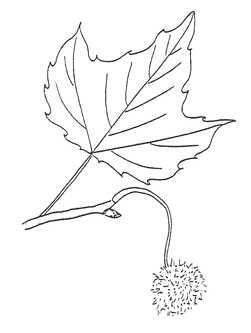Platanus occidentalis (plat’-a-nus ok-si-den-ta’-lis)
Family: Platanaceae, Sycamore
Key Steps
- 1b – Alternate leaf arrangement — go to 18
- 18a – Leaf simple — go to 19
- 19b – Thornless — go to 22
- 22d – All leaves lobed — go to 23
- 23a – Palmate venation — go to 30
- 30b – Leaves pale green beneath. Petiole round and hollow where attaches to stem — American Sycamore
- 23a – Palmate venation — go to 30
- 22d – All leaves lobed — go to 23
- 19b – Thornless — go to 22
- 18a – Leaf simple — go to 19
Description
 Leaf: Maple-like, large, up to 10 inches wide, glossy, hairless except veins beneath. 3-7 shallow lobes, large teeth. Lobes wider than long. Petiole is 2-4 inches long, stout, with hollow base. Stipules saucer-like, toothed, encircling stem.
Leaf: Maple-like, large, up to 10 inches wide, glossy, hairless except veins beneath. 3-7 shallow lobes, large teeth. Lobes wider than long. Petiole is 2-4 inches long, stout, with hollow base. Stipules saucer-like, toothed, encircling stem.
Bud: Inside the base of the petiole. Red/brown, cone-shaped, smooth, shiny. Single visible bud scale. True terminal bud absent.
Leaf Scar: Surrounds bud. Many bundle scars.
Stem: Stout, round zigzag. Stipule scars encircle stem. Small branches are white.
Bark: Older bark mottled, brown/white/yellow.
Pith: Pale brown, solid.
Flower: Round heads, reddish yellow on previous year’s wood.
Fruit: Brown, 1 inch diameter ball. Usually 1 smooth ball per stalk. Long (3-6 inch) fruit stalk.
Habit: Large shade tree. Irregular branching. 40+ feet tall.
London Planetree, P. x acerifolia — Very similar to Sycamore except terminal lobe is as wide as it is long or longer. Fruit usually pairs.
Resources




